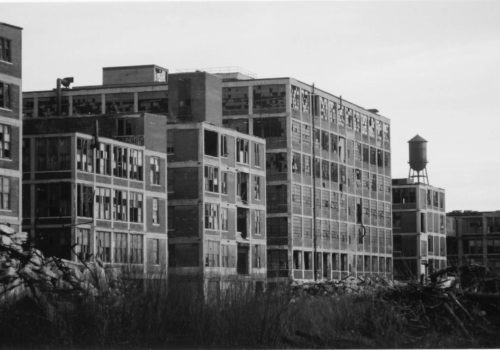Ruins. Empty hollow shells of what once was. Disarray, deshabille, the beautiful poetry of decay. Buildings that once stood, fully functional, making themselves useful to the people that created them to serve a greater purpose. But time passes and use falls away, and buildings that once were designed to serve us are no longer necessary. And, if the land is not wanted, there is no need to tear them down. Instead they are abandoned, left behind, reclaimed by nature ever so slowly.
As Harry Skrdla writes in the introduction to his book, Ghostly Ruins: America’s Forgotten Architecture (Princeton Architectural Press), “We construct buildings not just as shelter, but as frameworks of life—templates within which to conduct the business of living. Each one is designed for a purpose: a place to reside, a place to bank, a place to make things. They are occupied by, and surrounded with, living breathing human beings…as long as they serve a purpose. But when their reason for existence is gone and the people drift away, only memories remain.”
Skrdla traveled around the country in search of buildings that are but remnants of their former splendor. Collected here are thirty such locations including homes and hotels, power plants and prisons, whole neighborhoods and even entire towns—what once was now becomes an eerie reminder of lives lived and long gone, haunting and poignant reminders of an earlier world. Skrdla explains, “An abandoned building is dead—as dead as any corpse left decaying in a field. But it too once lived, was animate, and in a sense, had a soul. Except that soul was us. We gave it life and meaning, motion and warmth. We put the spark of light behind the shade-lidded windows and the circulation in its corridors. It consumed supplies and excreted waste. The thing was alive and the life force was us.” The building, as we know it, is an extension of our lives themselves.
Ghostly Ruins is a cozy tome that takes us back to an earlier time in our country’s history. Organized by function, the book is divided into chapters that offer beautifully subjects for quiet contemplation in categories including Transportation, Industry, Commerce, Public Works, Home, and Amusement. It also includes two additional chapters on Reincarnation (restored buildings) and Epitaphs (buildings now permanently gone). In organizing the book by function, we begin to consider the larger way in which we, as public and private citizens of the world, conduct our affairs. We can consider all that we take for granted, all that seems permanent so easily can be stripped away, that buildings, most of all, offer us a sense of continuity within the ever shifting dynamics of so many lives that make the community strong.
Consider the Book-Cadillac Hotel in Detroit, Michigan, which was a first-class luxury hotel that, at 1,200 rooms, made it the second largest hotel in America when it opened in 1924. No expense was spared; the lobby had been furnished in breche violette marble, ornate iron railings, and gold leafed ornamentation. The ballrooms had crystal chandeliers. The restaurants were wood paneled. Every room had a a spectacular view and a private bath—a luxury of the time unknown to most people in the world. The hotel prospered until the city began to fall into disrepair, and by 1984 it shuttered its doors, never to re-open in the city’s whose decline stands for all that failed in twentieth century America. The hotel still stands, thirty-three stories tall. It has been stripped of its treasures, just like all the great ruins of civilizations that came before.
Contrast this with the City Hall IRT subway station in New York City, which had been built in 1904, and was more highly decorated than any other station in the entire city. Designed by the noted architectural firm of Heins and la Farge, and overseen by Spanish-born architect Rafael Gustavino, the City Gall Station—which stands abandoned and perfectly intact—with terra cotta tiles of buff, cream, and chocolate brown on the curving vaults of the ceiling over the tracks and platform. Three ornate leaded-glass panels admit light from overhead while chandeliers featuring the then-brand-new Edison electric light illuminated the rest. The station was the pride of the entire subway system, until it was abandoned when the sinuous curve that defined the station could no longer accommodate the train cars introduced in later years. Today the City Hall Station stands, entrances sealed and skylights covered, though urban adventurers know how to access it for their private photo shoots.
The abandoned buildings of Ghostly Ruins stand as a monument to the ingenuity and vision of the American mind, to its wealth and its greatness that is as easily lost as it is found. The photographs provide us with a dynamic history of these spaces, illustrating the inevitability of change in all facets of waking life.
















